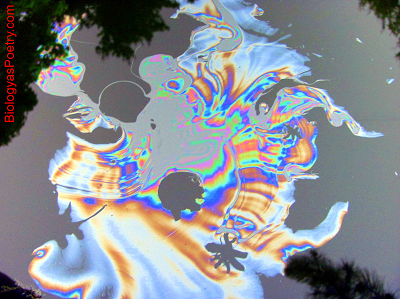∞ generated and posted on 2016.08.24 ∞
Property of a substance indicating propensity to display relatively low affinity for water and other polar substances.
Nonpolar substances are hydrophobic, though only portions of molecules too can be hydrophobic. An example of the latter are detergents, soaps, phospholipids, and cholesterol, all of which possess hydrophilic regions in combination with hydrophobic ones.
Lipids are defined as biological molecules that predominantly are hydrophobic. See also hydrophobic exclusion as well as lipid bilayer.

Figure legend: This is some sort of waxy substance we found on the surface of the fish/frog pond. The color is not the hydrophobicity, and nor is the fact that it is floating, but instead it is the lack of mixing with the water that indicates that the substance is likely to be hydrophobic. Note that Picasa was used to improve upon the color saturation. Photograph by Talia Abedon.
Hydrophobic substances tend to poorly dissolve in water regardless of size and are not easily "wet" if they are larger in size. "Magic sand" is an example of the latter: